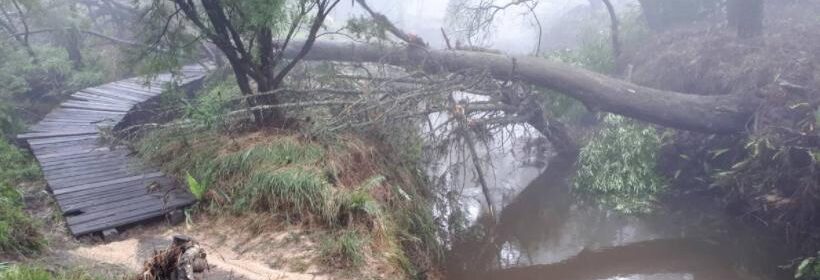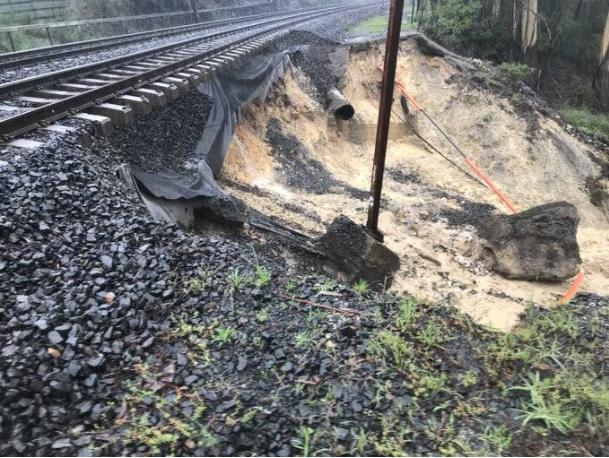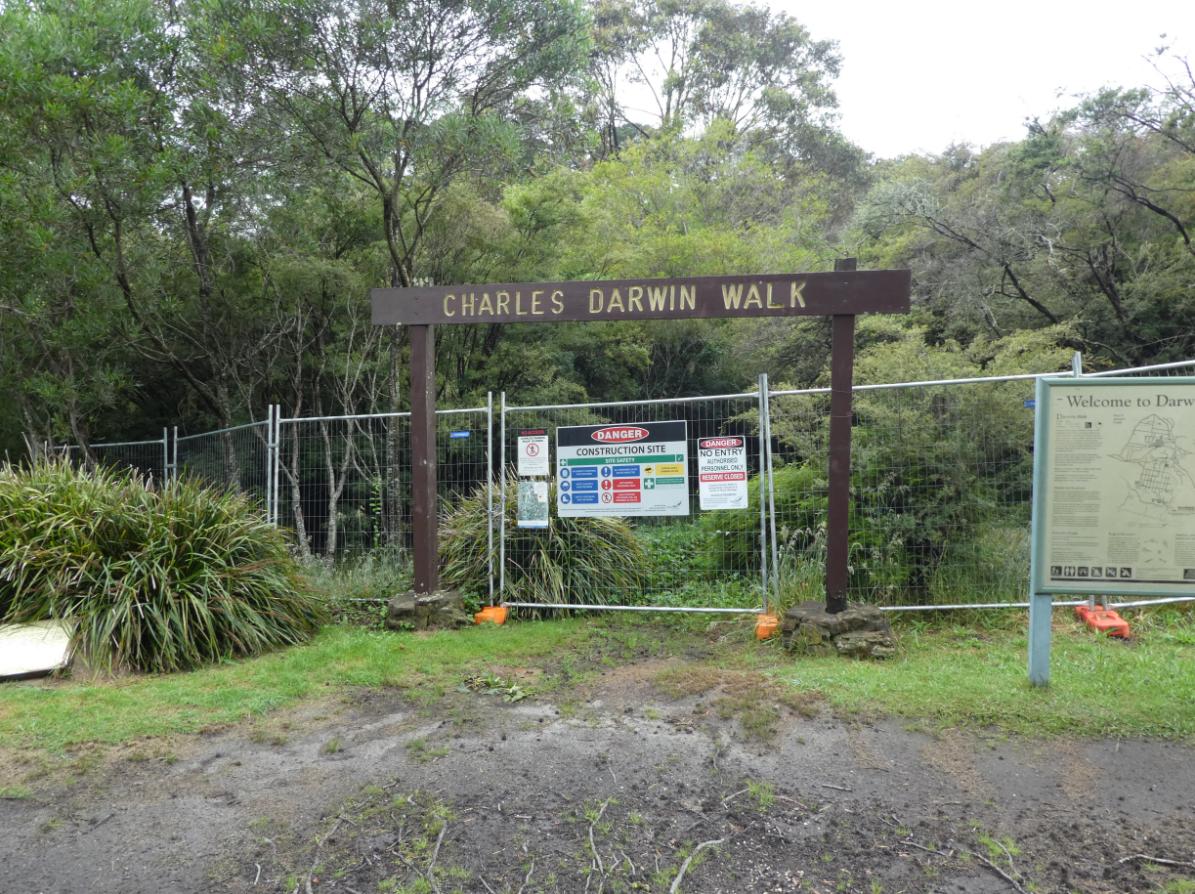Blue Mountain’s Council Mayor Mark Greenhill has presided over perpetual hiking track closures since February 2020, and it’s nearly two years on.
Leura Cascades was closed in February 2020 during a known and predictable La Niña period heavy rainfall weather pattern which deluged the east coast of New South Wales including the Blue Mountains region. Substandard stormwater drainage brought on a large landslip below the southern end of Govett Street in Katooomba, washing the embankment across popular Cliff Drive (below).
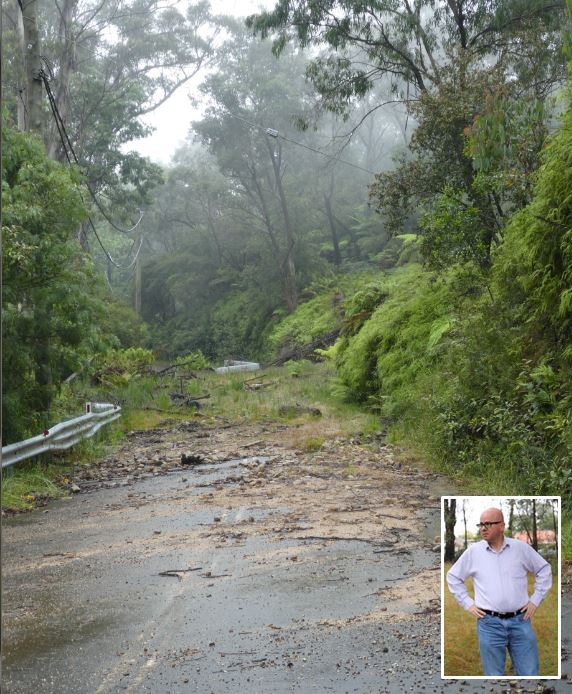
Landslip over Cliff Drive in Katoomba, near Leura Cascades Picnic Area (concerned mayoral insert, but at Springwood)
Cliff Drive here still remains closed and is expected remain so until some time during 2022. It took council over a year and a half to just partially open Leura Cascades Picnic Area in June 2021 to allow local dog walkers (resident voters).
Mayor Greenhill has used the oft-used excuse of the landslip being due to a supposed ‘1-in-100 year rainfall event’. This was the same excuse used by the state roads authority back in 2005 during the previous La Niña heavy rainfall period when unchecked road works caused considerable silting up of surrounding waterways flowing into the national park.
It’s all rather convenient to blame The Gods else Climate Change rather than duefully accepting responsibility for council’s dodgy stormwater drainage, or lack thereof.
Compare this with another substantial landslip that washed away the Blue Mountains Train line nearby between Leura and Katoomba stations early in February 2020, the same month. It took the state rail authority just twenty days to remediate the damage and to restore train services back to normal.
It’s about priorities, and invariably political ones.
A media report in the local Blue Mountains Gazette Newspaper dated 26th August 2020 stated:
“The February (2020) storms that caused extensive damage across the ‘city’ were declared a natural disaster, however bushland walking track and fire trail assets are not covered under natural disaster funding – only essential public infrastructure is.”
Yet, in addition both the federal and state governments offered funding grants to local government areas impacted by both the 2020 flooding events and the previous 2019 bushfires, including the Blue Mountains.
In May 2021, federal Senator Marise Payne announced funding of more than $869,000 to Blue Mountains Council under the federal government’s Roads to Recovery Programme. However, rather than remediate the roads impacted by the landslips, that gifted funding was redirected by council to highway road widening at Medlow Bath and Falconbridge (which the RTA should have done) and to resealing residential street in Katoomba and Wentworth Falls. Hardly urgent priorities! Hardly helping to restore Blue Mountains devastated tourism!
Millions of more dollars were available from Canberra under the federal Local Road and Community Infrastructure Programme and it bringing forward its $1.3 billion of the 2020-21 Financial Assistance (pandemic) Grant.
Mayor Greenhill has stated:
“This program focuses on all road users and their safety. Like most councils on the east coast of Australia, we are facing major road maintenance issues following the incredible amount of rain this summer. The council has allocated enormous extra resources to get those repairs done. While this federal funding is for different purposes, the two programs will see an enormous focus on roads in the months ahead.”
All talk. So what about Cliff Drive? What about the dozens of hiking tracks that have remained closed since early 2020? What about Bullaburra’s Red Gum Park Bridge for instance?
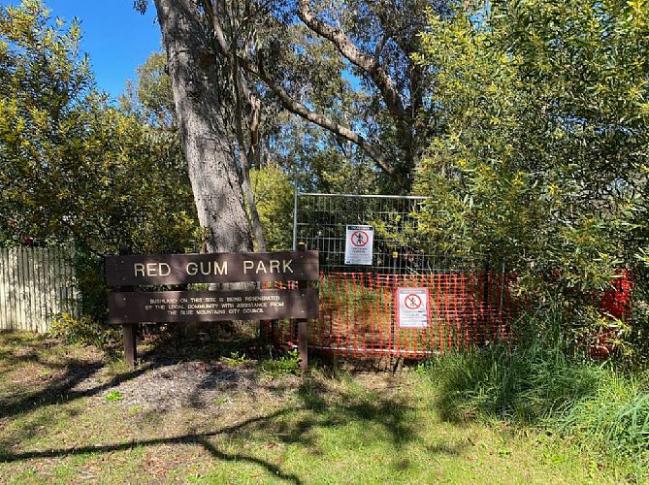
Track closures beset the Blue Mountains
This popular footbridge was also badly damaged in during February 2020 and has been closed ever since, apparently waiting for funding.
Well, instead this is where council’s infrastructure funding is going:
- $30,000 for a dog fence at Whitton Park in Glenbrook (Councillor Greenhill’s Ward 4 voter catchment)
- $5,200,000 for (urban) park upgrades and extravagant fancy ‘play spaces’ at Wentworth Falls Lake Park, Glenbrook District Park (Ward 4), Springwood’s Buttenshaw Park, Blackheath’s Soldiers Memorial Park
- $870,000 to tart up Katoomba’s retail high street in pink pebblecrete
- $3,000,000 for an extravagant concrete amphitheatre at Echo Point that no-one uses
- $229,000 for a new bicycle and walking link for Ellison Public School in Springwood
- $145,000 for art murals and scupltures around Katoomba – paint it and they (tourists) will come?
- $209,000 for re-paving the bitumen section of Terrace Falls Road in Hazelbrook, but not surfacing the southern gravel section to the falls.
- $725,000 to re-bitumen Sinclair Crescent (the road didn’t need it – it’s was already bitumen and in good condition)
- $140,000 to bitumen a new car/bus park at exposed and unfenced Lincoln Rock on Kings Tableland north of Wentworth Falls – to encourage more dangerous cliff edge selfies and rescues?
- etcetera..
Priorities seriously?
It all seems to be all about the political priorities of councillors, like appealing to residential voters, rather than non-voting tourists. So much for the Blue Mountains being a tourist destination.
And what about poor old Charles Darwin Walk? It’s also been closed since flooding and landslips in July 2020. This walk is an easy grade and so popular with visitors who are not as well abled and fit to undertake the strenuous descents and climbs accessing the Jamison Valley. And it’s one of the few walks accessible by train from Sydney, starting just a 200 metre walk from Wentworth Falls railway station (which has an platform elevator).
Passing through community land under Council’s custodianship, Charles Darwin Walk meanders along the Jamison Creek’s riparian gully through an array of native vegetation to the top of the actual falls of Wentworth Falls.
Over the years, Council has spent hundreds of thousands adding boardwalks and footbridges, but clearly none sturdy enough to withstand periodic La Niña heavy rainfall events. Now there’s a million dollar bill to re-do the track infrastructure. What a waste!
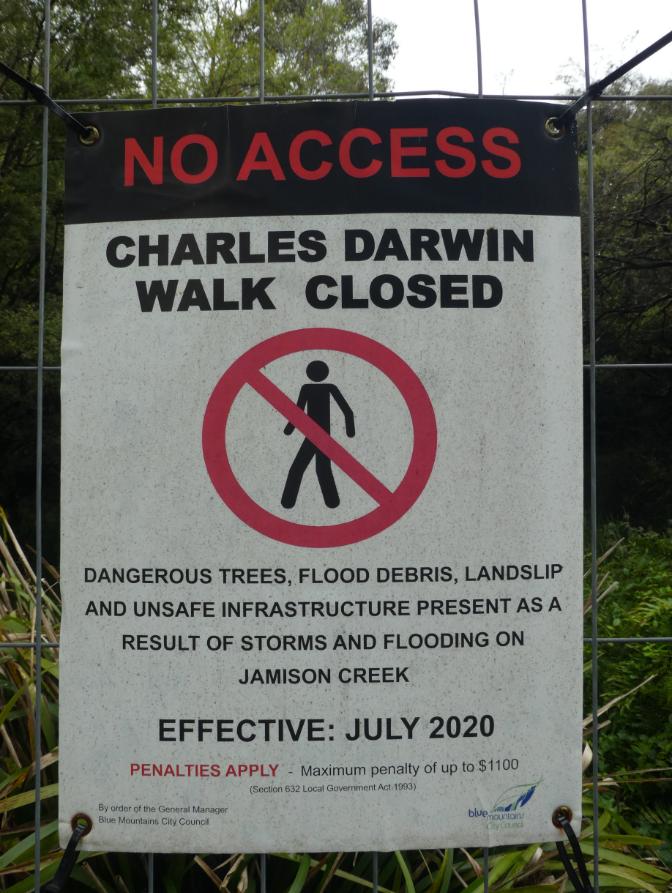
Council Tourism Message: “Go away or we will fine you!”
Council estimates it will cost $1 million to fix the historic 2.4 km Charles Darwin Walk and it would not be possible to reopen without support from the state or federal government. It’s where the naturalist Charles Darwin, who developed the theory of evolution, visited in 1836 as part of his voyage of the Pacific on the Beagle. Charles Darwin came to this area because of its unique natural beauty, plants and wildlife.
One hiker observed:
“Charles Darwin walked there – you would think with its heritage, that state and federal governments would be falling over themselves to fix it.”
As the local newspaper has quipped…”Darwin walked there, but we can’t.”
Blue Mountains Council claims on its ‘walking track’ webpage that it manages 135kms of walking tracks in the Blue Mountains. ‘Manages’ is a subjective term here, give all the notifications of track closures, changes and upgrades.
This is an extract of what it currently reads:
‘FIRE TRAILS MAINTENANCE WORK – POSTED 7 SEPTEMBER 2021
Council will be undertaking essential maintenance work on fire trails in the vicinity of Hall Pde, Fern Ave, Rocklea St and Brook St Hazelbrook in preparation for the upcoming fire season. Work is planned to start on Monday 13 September and is expected to take at least 4 weeks.
The trails will be closed for public use between 7am and 4pm Monday to Friday for safety reasons and to allow the work to be completed in a timely and efficient manner. The trails will be open for public use outside of these times.
NOTICE: Closures due to helicopter delivering materials, Wednesday 17 – Friday 19 November, 2021 – weather permitting.
National Parks & Wildlife Service will have a helicopter delivering materials for walking track repairs in the following areas: Pool of Siloam, Gordon Falls Picnic Area, Pool of Siloam Walking Track, Lyrebird Dell Walking Track, Lone Lyrebird Track and Golf Link lookout – weather permitting. View a map here. For more information visit the Park Alerts page for Blue Mountains National Park.
NOTICE: Helicopter working in the Blackheath Area, Friday 19 November, 2021 – weather permitting
National Parks & Wildlife Service will have a helicopter working in the Govetts Leap area of Blackheath, Friday 19 November, 2021 – weather permitting. View a map here. The helicopter is delivering walking track materials to areas that are currently closed as per the Park Alerts page for Blue Mountains National Park.
NOTICE: Helicopter working in the Blackheath Area, Thursday 28 October, 2021 – weather permitting
National Parks & Wildlife Service will have a helicopter working in the Pulpit Rock and Govetts Leap areas of Blackheath, Thursday 28 October, 2021 – weather permitting. The helicopter is delivering walking track materials to areas that are currently closed as per the Park Alerts page for Blue Mountains National Park.
Please note additional closures for the operation: Fairfax Walking Track, Cliff Top Track between Govetts Leap and Braeside Track, George Phillips lookout, Govetts Leap lookout and Govetts Leap carpark.
CLOSED: Shortcut Track, Wentworth Falls
A section of the Short Cut Track at Wentworth Falls will be closed Monday 8 November – Friday 17 December, 2021. The track between Wentworth Falls Picnic Area and Murphys Lane will be closed Mondays to Fridays. The track will remain open on weekends.
Leura Cascades
Leura Cascades reopened in June 2021 for pedestrians and cyclists. Please note: The public toilets are still closed. Read Media Release: Leura Cascades to partially reopen
Click here to view the map – Leura Cascades Precinct Status – Pedestrian and Bike Access
Click here to view the map – Leura Cascades to Gordon Falls
CLOSED: Charles Darwin Walk, Wentworth Falls
Due to flood damage and associated hazards Charles Darwin Walk, Wentworth Falls is temporarily closed until further notice.
PARTIALLY CLOSED: Sections of Prince Henry Cliff Walk
Prince Henry Cliff Walk is temporarily closed, due to landslip and storm damage. Tracks are physically closed, signposted with maps and alternate route options via Olympian Parade.
PARTIALLY CLOSED: Redgum Reserve Bullaburra
A section of walking track exiting onto Boronia Rd is closed due to the failure of a footbridge. Through-access between DeQuency and Cottle Roads is still open.
CLOSED: Hargraves Lookout
Please be advised of the temporary closure of Hargraves Lookout Precinct Blackheath for infrastructure upgrade and renewal works. Closure will be in effect from Friday 19 February 2021 until Monday 29 November 2021.
Please see attached notification and map. Click here to view the map.
For information on the Blue Mountains National Park visit the National Parks and wildlife Services webpage here.
Bush fire-effected walking track closures
The summer 2019/20 bushfires left significant hazards and damaged infrastructure in Council reserves. As a result, the following closures are still in place. These areas will remain closed until they are safe for the public to re-enter.
Read the Media Release: $1.25m in damage to Council’s bushland reserves after summer bush fires
It’s important to stay out of burned bushland areas as there are a range of serious dangers and hazards. Trees damaged by fire may be dangerous and fall down or drop branches and limbs, and structures such as bridges, steps and safety railings may also be damaged and unsafe.
Blackheath
Pulpit Rock Reserve
Popes Glen Reserve – the first 350m of Popes Glen Walk that was not impacted by fire is open (from Dell Street to Clarence Street). The rest of Popes Glen remains closed due to bushfires and flood damage. Please respect closures by keeping out. Click here to view the map.’
CONCLUSION:
Given that Blue Mountains Council’s infrastructure funding, whether derived either from local ratepayers or from state and federal government grant programmes, is prioritised to urban infrastructure and systemically away from managing and rehabilitating the natural areas under its custodianship, it is appropriate that the natural areas of the Blue Mountains juxtaposed to the Blue Mountains National Park, including the 135kms of tourist hiking tracks, be transferred out of Council’s hands to the Parks Service.
Almost all the funding for tourism infrastructure in the Blue Mountains comes from either the New South Wales or federal governments anyway.
